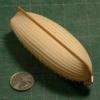-
Posts
13,302 -
Joined
-
Last visited
Content Type
Profiles
Forums
Gallery
Events
Everything posted by druxey
-
Sweet, Ben! Very neatly done, especially lining up those carlings.
- 889 replies
-

Mast Lengths and their above deck heights for HMB Endeavour
druxey replied to dashi's topic in Masting, rigging and sails
Interesting. The partial draught above does not appear to be ZAZ 6588, ZAZ 6587 or ZAZ 7844; the three sheer and profiles listed on the RMG site.- 63 replies
-
- HMB Endeavour mast lengths
- above deck mast heights
- (and 3 more)
-

Steamboats and other rivercraft - general discussion
druxey replied to Cathead's topic in Nautical/Naval History
My guess is that the bow mystery structure is a rub strip or bumper. Also, I note that the decks aft align vertically and are not stepped back.- 281 replies
-
- Steamboats
- riverboats
-
(and 3 more)
Tagged with:
-

Mast Lengths and their above deck heights for HMB Endeavour
druxey replied to dashi's topic in Masting, rigging and sails
Thanks for your recent responses on the subject, Dashi! It is interesting to note the early example of the Essex of 1741 with a mizen stepped on the lower deck, as well as Sutherland's comments. Thanks for bringing these to my attention.- 63 replies
-
- HMB Endeavour mast lengths
- above deck mast heights
- (and 3 more)
-
Two layer of SilkSpan mean only one glueing layer, which will be less tricky than bonding three layers of material. If you are using white glue which is water-soluble, you could subsequently dampen the flat double layer and let it dry over the form, perhaps? As for the mainsail exceeding the size of the material, could you stagger the joints along different seam lines?
-
Don't cover up all those wonderful joints! Beautiful work.
-
Do you actually need to use leather to imitate leather?
- 2,214 replies
-

HMCSS Victoria 1855 by BANYAN - 1:72
druxey replied to BANYAN's topic in - Build logs for subjects built 1851 - 1900
My condolences to you, as well as his family.- 1,005 replies
-
- gun dispatch vessel
- victoria
-
(and 2 more)
Tagged with:
About us
Modelshipworld - Advancing Ship Modeling through Research
SSL Secured
Your security is important for us so this Website is SSL-Secured
NRG Mailing Address
Nautical Research Guild
237 South Lincoln Street
Westmont IL, 60559-1917
Model Ship World ® and the MSW logo are Registered Trademarks, and belong to the Nautical Research Guild (United States Patent and Trademark Office: No. 6,929,264 & No. 6,929,274, registered Dec. 20, 2022)
Helpful Links
About the NRG
If you enjoy building ship models that are historically accurate as well as beautiful, then The Nautical Research Guild (NRG) is just right for you.
The Guild is a non-profit educational organization whose mission is to “Advance Ship Modeling Through Research”. We provide support to our members in their efforts to raise the quality of their model ships.
The Nautical Research Guild has published our world-renowned quarterly magazine, The Nautical Research Journal, since 1955. The pages of the Journal are full of articles by accomplished ship modelers who show you how they create those exquisite details on their models, and by maritime historians who show you the correct details to build. The Journal is available in both print and digital editions. Go to the NRG web site (www.thenrg.org) to download a complimentary digital copy of the Journal. The NRG also publishes plan sets, books and compilations of back issues of the Journal and the former Ships in Scale and Model Ship Builder magazines.


